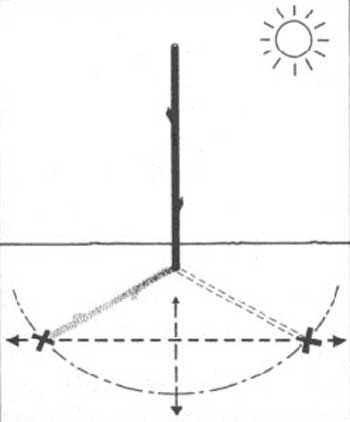The other night I was looking at the crescent moon. Many readers of this blog are doubtless familiar with how to find direction from the moon, but some will not be, so indulge me for a moment. By drawing an imaginary line between the horns of the crescent and extending it down to the horizon the approximate position of south can be estimated if in the northern hemisphere, or north if you are in the southern hemisphere.
 Idly I wondered if the angle of this line had any relationship to the latitude of the observer. I recalled there was something about navigating by moon in the Japanese Manual of Night Movements.
Idly I wondered if the angle of this line had any relationship to the latitude of the observer. I recalled there was something about navigating by moon in the Japanese Manual of Night Movements.
“Although it is difficult to determine direction by the position of the moon, the latter has the advantage of being recognizable even on nights when all the stars cannot be seen. The moon crosses the meridian about noon on the first lunar day, and it moves about fifty minutes behind the sun every day. Therefore, if the age of the moon be known, the approximate passing of the meridian can be easily computed. Its approximate age can be computed from the shape of its bright portion.”
Not really that helpful! Something may have been lost in the translation. Most websites I looked at had no answer but eventually I found this interesting paper and found the answer is “no”.
I later confirmed my latitude was 51 degrees so an angle of either 51 or 39 would have been expected if the hypothesis had been correct. The range of angles the terminator can be at as it approaches and passes meridian will vary with latitude, however, but this has very little application to practical emergency navigation.
An alternate method for direction finding by the moon involves remembering that the sun sets in the west and rises in the east. If the moon is up in the early part of the night, or in the evening before the sun has gone down the illuminated side will be the western. If the moon is observed in the latter part of the night or in the morning then the eastern side will be illuminated. In this context “latter” and “early part” of the night are defined in relation to the median point of the night, also known as Solar Midnight. In other words, the middle of the period of darkness rather than the chronological “midnight”, 12:00am or 0000hrs on the clock. This is more of a secondary method since if you can see the light and dark parts of the moon you can use the terminator method to find north or south. I suppose you could make a crude estimate of the time by establishing where south or north is located and then observing which side of the moon was illuminated.
You can also estimate direction from the moon using the shadow tip method. This is often illustrated using the sun but the principle is exactly the same using the moon. Place an object such as a stick in the ground so that it casts a shadow. Mark the tip of the shadow. Wait for at least fifteen minutes so the shadow has time to move. Mark the tip of the shadow’s new position. A line drawn between these two points will run east-west. The first point you marked will always be west, the second east. Easy for me to remember since my name is “West” so “West comes first!”. Both the moon and the sun move from east to west and in the northern hemisphere they are always in the southern half of the sky so shadows cast have varying degrees of northward orientation. A line perpendicular to the east-west line will be north-south and the shadow will be in the direction of the pole of the hemisphere that you are in.
The advantage of the shadow tip method is that you can use it when there is a full moon and you could not use the terminator method. In the daytime you can use the shadow tip method when the exact position of the sun cannot be seen because of clouds, so long as there is enough light to throw a shadow.
If you have enjoyed this article or it has been helpful to you please feel free to show your appreciation. Thank you.
The Books








